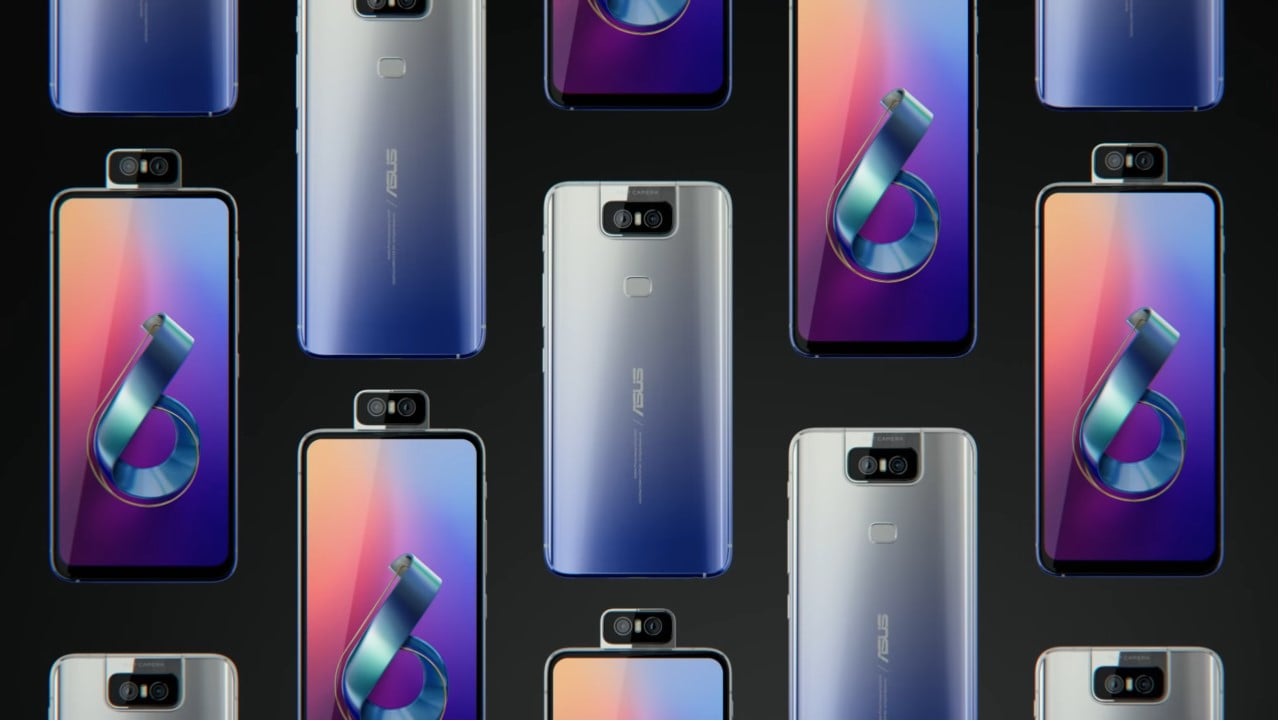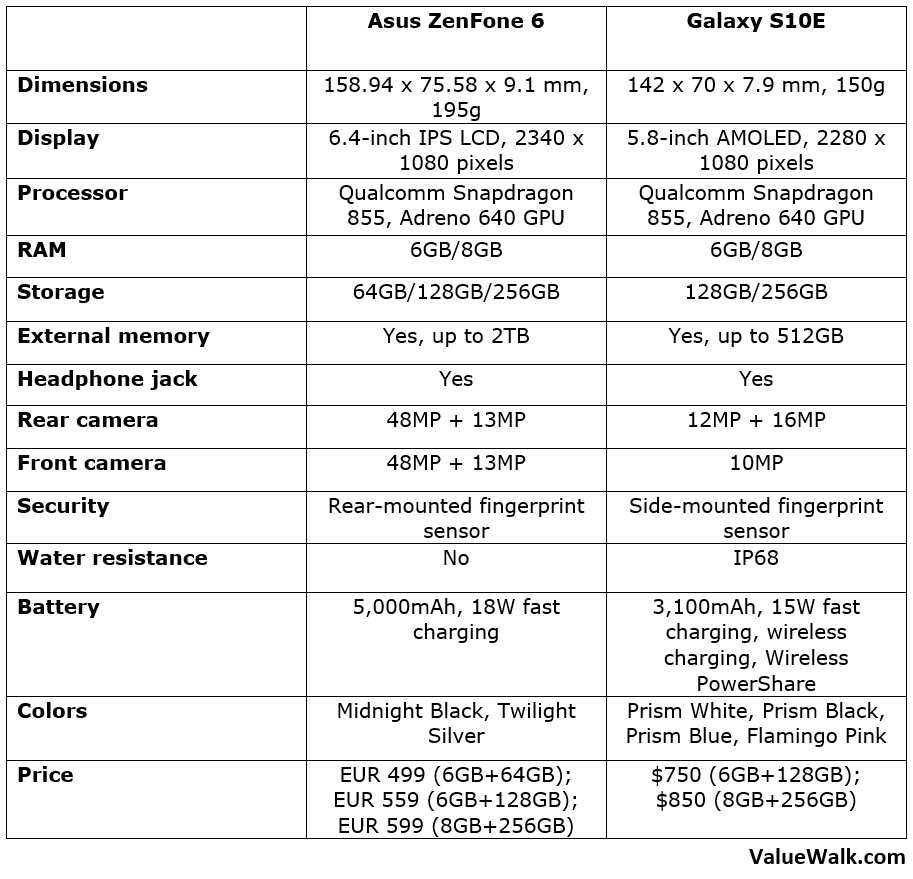Premium smartphone vendors such as Samsung are trying to lure customers by launching an ‘affordable’ version of the flagship smartphones. Samsung’s Galaxy S10E is not exactly ‘affordable’ but it’s cheaper than the S10 and S10 Plus. Last week, Asus launched the ZenFone 6 to take on devices like Galaxy S10E by offering similar specs at even lower prices. Let’s dive into a detailed ZenFone 6 vs Galaxy S10E comparison to see which one is a better buy.
ZenFone 6 vs Galaxy S10E: Design
The ZenFone 6 boasts a premium design. It has a notch-less display but there is still thin chin at the bottom of the screen. It offers dual stereo speakers and the 3.5mm headphone jack. Its rear panel has gradient colors. The back panel is curved on the sides, making it easier for you to hold the device in hand.
Its biggest highlight is the Flip Camera setup that also serves as selfie camera. It eliminates the need for a display notch. Made out of Liquid Metal, the Flip Camera module houses two lenses. It flips around to the front whenever you need to take a selfie or make video calls. Asus has tested it for 100,000 flips.
The Flip Camera setup can retract itself automatically if you accidentally drop the phone. It also allows you to control the amount of rotation, meaning you can take pictures at different angles. It measures 158.94 x 75.58 x 9.1 mm and weighs 195g. Asus has launched the ZenFone 6 in Twilight Silver and Midnight Black colors.
The ZenFone 6’s front and rear glass panels are supported by a series 6000 aluminum frame in the middle. It comes with a Smart Key that you can use to trigger Google Assistant. You can also customize the Smart Key button to launch other apps.
The Galaxy S10E also boasts an elegant design. On the front, it gets a nearly bezel-less hole-punch display that houses the selfie camera in a circular hole in the top right corner of the screen. Its rear panel is made out of glass to facilitate wireless charging. It measures 69.9 x 142.2 x 7.9mm and weighs just 150g, which makes it smaller, thinner, and lighter than ZenFone 6.
The S10E offers an IP68 rating for water resistance and also supports wireless charging. The ZenFone 6 lacks both these features. The Samsung device retains the 3.5mm headphone jack. It comes in Prism White, Prism Blue, Prism Black, and Flamingo Pink color options.
While the ZenFone 6 has a rear-mounted fingerprint sensor, the S10E has the fingerprint reader embedded in the power button on the side. It is fast, secure, and convenient.
ZenFone 6 vs Galaxy S10E: Display
Samsung has used a superior OLED display while the ZenFone 6 comes with a traditional IPS LCD screen. The ZenFone 6 sports a 6.3-inch IPS LCD screen with Full HD+ resolution of 1080 x 2340 pixels. Its display is protected by Corning’s Gorilla Glass 6. It has a 19.5:9 aspect ratio, 92% screen-to-body ratio, and 600 nits of peak brightness.
Thanks to Samsung’s expertise in OLED technology, the Galaxy S10E delivers more vibrant colors, bright whites, and true blacks. It offers an immersive visual experience. The phone gets a 5.8-inch Dynamic AMOLED display with 19:9 aspect ratio and Full HD+ resolution of 1080 x 2280 pixels. It has 438ppi of pixel density. The screen is protected by Corning’s Gorilla Glass 5.
ZenFone 6 vs Galaxy S10E: Internal specs
Both handsets run the same octa-core Qualcomm Snapdragon 855 processor paired with Adreno 640 GPU. You can expect the same premium performance from ZenFone 6 as Samsung’s Galaxy S10E. In markets outside the US and China, Samsung sells the S10E running its own Exynos 9820 chipset with Mali-G76 GPU.
The ZenFone 6 is available in three different configurations: 6GB RAM with 64GB storage, 6GB RAM with 128GB storage, and 8GB RAM with 256GB storage. It features a microSD card slot supporting up to 2TB of external storage.
The Galaxy S10E comes in two variants: one with 6GB RAM and 128GB internal storage and another with 8GB RAM and 256GB storage. Samsung has also added a microSD card slot with support for up to 512GB of external memory.
ZenFone 6 vs Galaxy S10E: Battery
The ZenFone 6 ensures that you don’t have to worry about running out of battery often. It packs a giant 5,000mAh battery with support for Quick Charge 4 technology. Asus claims the battery easily lasts up to two days of normal usage on a single charge. It offers 18W fast charging but lacks wireless charging. The larger battery size will lead to fewer charging cycles, which should extend the battery longevity.
The S10E includes a 3,100mAh battery with 15W fast charging. It also supports wireless charging and Wireless PowerShare, which lets you charge accessories and other devices by putting them on the back of S10E. The Samsung phone has a smaller 5.8-inch display, so the battery should easily last a full day of normal usage.
Software
Both the ZenFone 6 and Galaxy S10E run the same Android 9 Pie software, but with a different skin on top. So, the user experience is different. The S10E runs Samsung’s new One UI skin, which offers a smooth and intuitive interface, especially on large screens. It displays navigation options near the bottom of the display to ensure they are within your thumb’s reach, while the content is displayed in the top half of the screen.
The ZenFone 6 runs Asus’ revamped Zen UI 6 skin, which is pretty close to the stock Android experience. Asus has made it fast and clean. It brings better memory management, faster launch times, and speed improvements. Asus has promised to upgrade the software to Android Q and Android R in the future. The ZenFone 6 will also get at least two years of security patches.
Camera
Samsung has been pushing the limits of smartphone photography with its flagship models, but the Galaxy S10E doesn’t have the same camera capabilities as the more expensive Galaxy S10 or S10 Plus. It gets a dual camera setup on the back and a single lens on the front for selfies.
The S10E sports a 12MP wide-angle lens with variable apertures and a 123-degree 16MP ultra-wide angle lens with f/2.2 aperture on the back. It supports OIS and 4K video recording at 30fps. Its wide-angle lens automatically switches between the two apertures depending on ambient light to take the best possible shot. For selfies, it has a 10MP lens with f/1.9 aperture in the top right corner of the screen.
The ZenFone 6 sports a Flip Camera mechanism that serves as both the front and rear cameras. The camera module flips out to the front whenever you need to take selfies. Asus has used a 48MP Sony IMX586 sensor with dual LED flash and f/1.8 aperture. It is accompanied by a 13MP ultra-wide angle lens. The high-resolution dual cameras can take excellent selfies.
The ZenFone 6 can record 4K videos at 60fps with EIS. Its other features include the HDR+ Enhanced mode and Night Mode.
Price
Asus is currently taking pre-orders for its new phone in Europe via its website. The device will go on sale on May 25th. The ZenFone 6 has a competitive pricing. It starts at EUR 499 for the 6GB+64GB version and goes up to EUR 559 for the 6GB+128GB model. The top of the line 8GB+256GB model has been priced at EUR 599.
The Galaxy S10E is more expensive than the ZenFone 6. It starts at $750 for the 6GB+128GB version and goes up to $850 for the 8GB+256GB variant. For the additional cost, the S10E gets you wireless charging, water resistance, Wireless PowerShare, and a superior OLED display.






